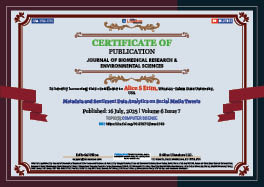Alice S Etim*
Volume6-Issue7
Dates: Received: 2025-06-21 | Accepted: 2025-07-15 | Published: 2025-07-16
Pages: 884-890
Abstract
The outbreak of COVID-19 pandemic in early 2020 led to decisions by both the federal and state governments in the United States of America (hereafter, governments) to implement policies about staying at home to reduce the spread of the COVID-19 virus. With the closure of many businesses, people worked from home and schools moved face-to-face classes to online or remote learning. People were concerned about the policies and the impact of such policies on their livelihood. Social media websites such as Twitter (X) were used to voice opinions about the challenges posed by the stay-at-home orders. People expressed positive and negative sentiments about the closures and reopening of offices, schools, restaurants, and other public places as well as the impact of the government stay-at-home policies. This article examines both the positive and negative sentiments expressed using the tweets from the Twitter (X) platform. The metadata and sentimental data collected via the social media site, Twitter (X) for three states – North Carolina, Pennsylvania, and California on the pandemic, stay-at-home and reopening policies were analyzed and discussed. The study adds value to existing literature about COVID-19 in understanding people’s opinions, better information sharing by governments, scientists and others that influence policy decisions in cases of future public health crisis.
FullText HTML
FullText PDF
DOI: 10.37871/jbres2143
Certificate of Publication

Copyright
© 2025 Etim AS, Distributed under Creative Commons CC-BY 4.0
How to cite this article
Etim AS. Metadata and Sentiment Data Analytics on Social Media Tweets. J Biomed Res Environ Sci. 2025 Jul 16; 6(7): 884-890. doi: 10.37871/jbres2143, Article ID: JBRES2143, Available at: https://www.jelsciences.com/articles/ jbres2143.pdf
Subject area(s)
References
- Delorey TM, Ziegler CGK, Heimberg G, Normand R, Yang Y, Segerstolpe Å, Abbondanza D, Fleming SJ, Subramanian A, Montoro DT, Jagadeesh KA, Dey KK, Sen P, Slyper M, Pita-Juárez YH, Phillips D, Biermann J, Bloom-Ackermann Z, Barkas N, Ganna A, Gomez J, Melms JC, Katsyv I, Normandin E, Naderi P, Popov YV, Raju SS, Niezen S, Tsai LT, Siddle KJ, Sud M, Tran VM, Vellarikkal SK, Wang Y, Amir-Zilberstein L, Atri DS, Beechem J, Brook OR, Chen J, Divakar P, Dorceus P, Engreitz JM, Essene A, Fitzgerald DM, Fropf R, Gazal S, Gould J, Grzyb J, Harvey T, Hecht J, Hether T, Jané-Valbuena J, Leney-Greene M, Ma H, McCabe C, McLoughlin DE, Miller EM, Muus C, Niemi M, Padera R, Pan L, Pant D, Pe'er C, Pfiffner-Borges J, Pinto CJ, Plaisted J, Reeves J, Ross M, Rudy M, Rueckert EH, Siciliano M, Sturm A, Todres E, Waghray A, Warren S, Zhang S, Zollinger DR, Cosimi L, Gupta RM, Hacohen N, Hibshoosh H, Hide W, Price AL, Rajagopal J, Tata PR, Riedel S, Szabo G, Tickle TL, Ellinor PT, Hung D, Sabeti PC, Novak R, Rogers R, Ingber DE, Jiang ZG, Juric D, Babadi M, Farhi SL, Izar B, Stone JR, Vlachos IS, Solomon IH, Ashenberg O, Porter CBM, Li B, Shalek AK, Villani AC, Rozenblatt-Rosen O, Regev A. COVID-19 tissue atlases reveal SARS-CoV-2 pathology and cellular targets. Nature. 2021 Jul;595(7865):107-113. doi: 10.1038/s41586-021-03570-8. Epub 2021 Apr 29. PMID: 33915569; PMCID: PMC8919505.
- Etim A, Yarber L. COVID-19 vaccine hesitancy: Analyzing risk factors impacting minority populations’ acceptance/adoption and ICT-based solutions. In: Etim A, editor. Adoption and use of technology tools and services by economically disadvantaged communities: Implications for Growth and Sustainability. IGI Global; 2024.
- US coronavirus vaccine tracker. USAFacts.
- Charumilind S, Craven M, Lamb J, Singhai S, Wilson M. Pandemic to endemic: How the world can learn to live with COVID-19. McKinsey & Company. 2021.
- Chou WS, Budenz A. Considering Emotion in COVID-19 Vaccine Communication: Addressing Vaccine Hesitancy and Fostering Vaccine Confidence. Health Commun. 2020 Dec;35(14):1718-1722. doi: 10.1080/10410236.2020.1838096. Epub 2020 Oct 30. PMID: 33124475.
- Cowan SK, Mark N, Reich JA. COVID-19 vaccine hesitancy is the new terrain for political division among americans. Socinus: Sociological Research for a Dynamic World. 2021;7:237802312110236. doi: 10.1177/23780231211023657.
- Bansal A, Gupta C, Muralidhar A. A sentimental analysis for youtube data using supervised learning approach. International Journal of Engineering and Advanced Technology (IJEAT). 2019.
- Kates J, Orgera K. The red/blue divide in COVID-19 vaccination rates. KFF. 2021.
- Habib MA, Anik MAH. Impacts of COVID-19 on Transport Modes and Mobility Behavior: Analysis of Public Discourse in Twitter. Transp Res Rec. 2023 Apr;2677(4):65-78. doi: 10.1177/03611981211029926. Epub 2021 Aug 10. PMID: 37153163; PMCID: PMC10149523.
- Airak S, Sukor NSA, Rahman NA. Travel behaviour changes and risk perception during COVID-19: A case study of Malaysia. Transportation Research Interdisciplinary Perspectives. 2023 Mar;18:100784. doi: 10.1016/j.trip.2023.100784.
- Chintalapudi N, Battineni G, Amenta F. Sentimental Analysis of COVID-19 Tweets Using Deep Learning Models. Infect Dis Rep. 2021 Apr 1;13(2):329-339. doi: 10.3390/idr13020032. PMID: 33916139; PMCID: PMC8167749.
- Biermann K, Taddicken M. Visible scientists in digital communication environments: An analysis of their role performance as public experts on Twitter/X during the COVID-19 pandemic. Public Underst Sci. 2024 May 21;34(1):9636625241249389. doi: 10.1177/09636625241249389. Epub ahead of print. PMID: 38771041; PMCID: PMC11673311.
- Xing Y, He Y, Zhang Z. Examining themes of social media users’ opinion on remote work during COVID-19 pandemic: A justice theory perspective. Library Hi Tech. 2023;43(1):249-273.






























































